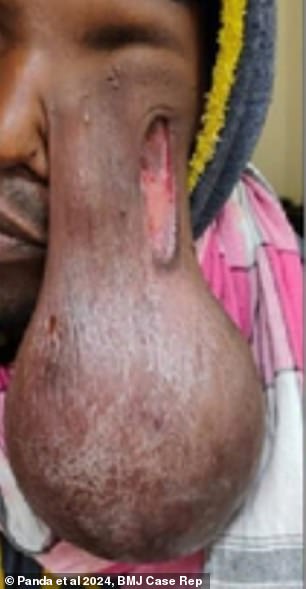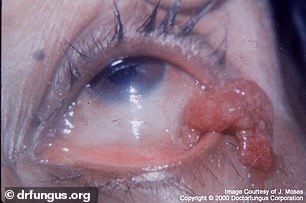A man was left blind and deformed after a parasite began reproducing in his eyeball.
This anonymous 30-year-old man from India developed a grapefruit-sized tumor on his eyelid that extended to his chest.
It started five years ago with a subtle swelling in his left eye, but over the years it grew so much that it stretched the skin on his face, pulling on the tissue that would have bordered his eye, leaving him unable to see.
When he finally sought help, doctors discovered a parasite that causes growths in the nose and eye structures.
The medical team believes the tumor was the body’s way of reacting to the parasite, inflaming the surrounding tissue.
They are not sure how long the man had the parasite in his body or where he got it from, but other people who contract the disease usually contract it by swimming or bathing in rural areas or in streams near farms.
Doctors determined that the unidentified man had an angiofibroma, a giant tumor, associated with rhinosporidiosis, a parasitic infection.
The two rarely occur simultaneously, the team wrote in a case report.
A brain scan before surgery showed the mass, made of skin and blood tissue, adhering to the man’s left eyelid.
The tumor, which was six inches in diameter and attached to a three-inch-long flap of eye tissue, was not cancerous, but still caused debilitating side effects.

The man’s tumor grew so large that it obscured his eye socket, leaving him unable to see.
Surgeons at the All India Institute of Medical Sciences operated to remove the mass from his eye, cutting the “huge” deformed blood vessels that had grown to support the lump, attempting to prevent massive blood loss.
The surgery was a success and within three months the man’s eye returned to normal and he could see again, the authors reported in The British Medical Journal.
Rhinosporidiosis infections are rare, but are most commonly reported in the tropical regions of India and Sri Lanka, although some cases have also been documented in South America, Africa, and the United States.
A 2021 study reported 286 cases of the condition between 1896 and 2019, and about 34 of those cases occurred in the US.
Most people with rhinosporidiosis are between 11 and 40 years old, and the condition is more common in men.
The disease is not fatal, and in some cases, people live with the lumps for a long time. A man reportedly lived with rhinosporidiosis for 30 years, according to medscape.
Scientists have been puzzled by the parasite that causes the infection, Rhinosporidium seeberi, for more than a century, since it was first identified in 1900.

Doctors performed surgery on the case study patient to remove the enormous growth on his face.
They have not been able to grow the parasite in a laboratory to study it, and scientists do not agree on whether it is a bacteria or a fungus.
They know that people who live in rural areas, on farms and swim in ponds or rivers are at greater risk of contracting the parasite.
Healthcare workers have found it difficult to treat the disease and tend to opt for surgery to eliminate it. However, this does not always work, as many people who develop the condition end up experiencing recurring lumps.
In some cases, doctors have successfully used an antibiotic cream called dapsone to address the problem, according to medscape.
Even more mysterious is the case of the Indian man. The researchers said rhinosporidiosis “rarely” occurs at the same time as angiofibromas.
These are noncancerous tumors that form from a combination of skin connective tissue, such as collagen, and blood vessels.

The above shows a patient with a rhinosporidiosis infection, the same infection that the patient in the Indian case study had.
They are often caused by genetic disorders and usually form inside the nose, making it difficult to breathe and causing problems with the sinuses, eyes or skull, depending on the University of Pittsburgh Medical Center.
The most common treatment for this is surgery. Sometimes radiation or hormone therapy is used to shrink remnants of the tumor that cannot be accessed with a scalpel.
The man in the case study did not appear to have any of the genetic conditions most commonly associated with this type of tumor.
The authors wrote that when they analyzed the cells within the tumor, they found small pieces of rhinosporidiosis parasites throughout the fleshy mass.
This suggests that the tumor may have been the body’s way of reacting to the intruder: inflaming the tissue until it clustered around the parasite, trying to contain or fight it.
The doctors wrote that her case “highlights the complexity of diagnosis and treatment of this rare combination of pathologies and emphasizes the need for careful treatment planning.”

